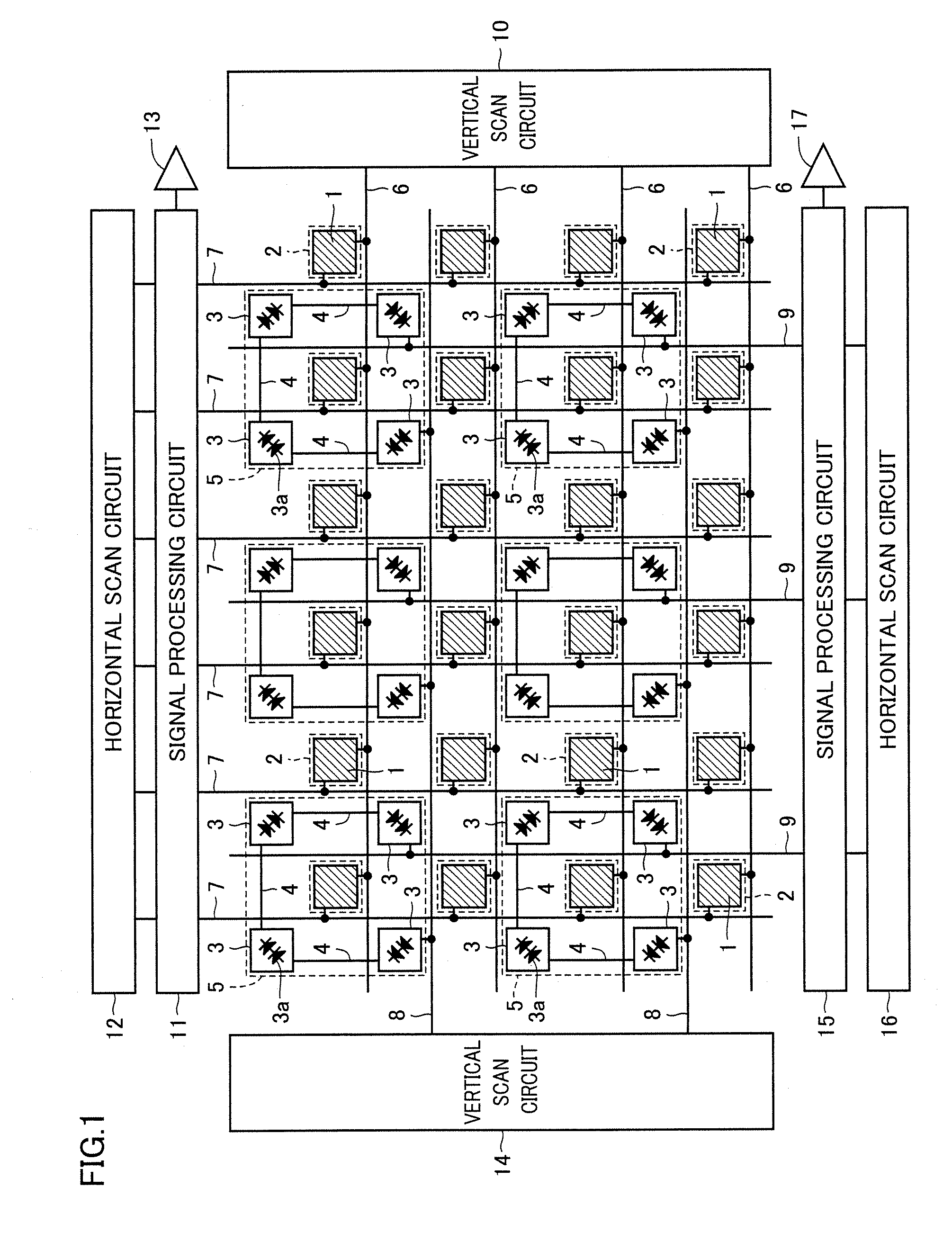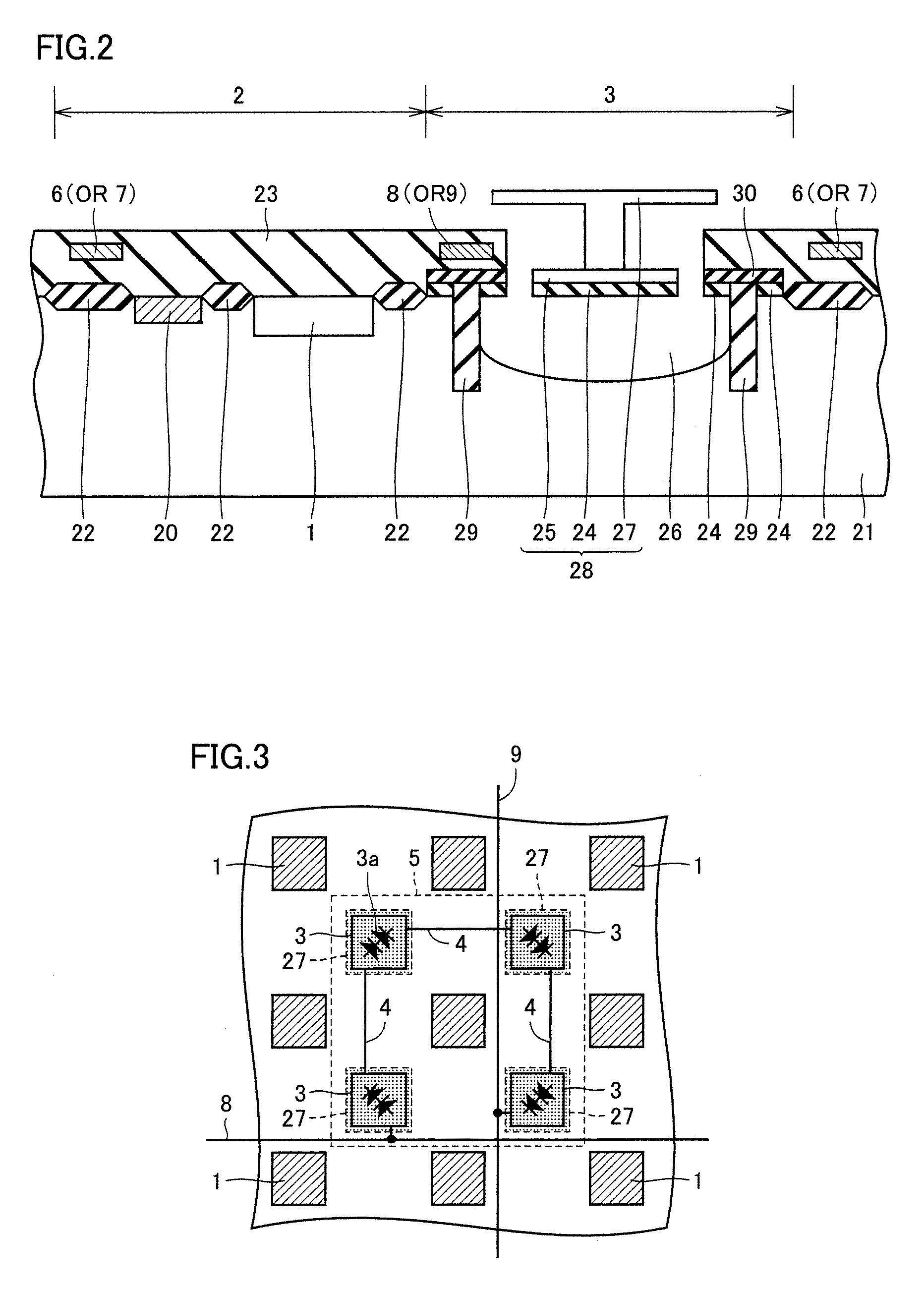Two-wavelength image sensor picking up both visible and infrared images
a technology of infrared and visible images, applied in the field of 2wavelength image sensors, can solve the problems of increased system size and production cost, disadvantageous resolution of visible image and thermal image, and large system size, and achieve the effect of eliminating the necessity of cooling, high resolution and high sensitivity
- Summary
- Abstract
- Description
- Claims
- Application Information
AI Technical Summary
Benefits of technology
Problems solved by technology
Method used
Image
Examples
first embodiment
[0023]FIG. 1 is a plan view in configuration of the 2-wavelength image sensor of the present invention in a first embodiment. As shown in FIG. 1, the 2-wavelength image sensor includes a detector array including a plurality of visible radiation detectors I and a plurality of uncooled infrared radiation detectors 3. While in reality a large number of detectors 1 and 3 are provided, FIG. 1 shows 24 detectors for each type of detector for simplicity. Twenty four visible radiation detectors 1 and 24 uncooled infrared radiation detectors 3 are uniformly dispersedly arranged. More specifically, 24 visible radiation detectors 1 are arranged in four rows and six columns with a predetermined pitch and so are 24 uncooled infrared radiation detectors 3, and visible radiation detectors 1 and uncooled infrared radiation detectors 3 are displaced by a half pitch in the direction of the rows and that of the columns.
[0024]Visible radiation detector 1 is implemented by a Si pn junction photodiode an...
second embodiment
[0041]FIG. 5 is a plan view of a main portion of the present 2-wavelength image sensor in a second embodiment in comparison with FIG. 3, and FIG. 6 is a cross section in configuration of two adjacent infrared radiation detectors 3.
[0042]In FIGS. 5 and 6 the 2-wavelength image sensor has thermal infrared radiation detecting pixel 5 formed of four infrared radiation detectors 3 with their infrared radiation absorbing umbrella structure 27 integrally formed. Accordingly, four infrared radiation detectors 3 in a single thermal infrared radiation detecting pixel 5 are mutually thermally coupled. Accordingly, their respective hollow structures are equal in temperature. The value will be substantially a mean value of the temperatures of the four hollow structures that would be attained when they are thermally independent. The remainder in configuration and operation is identical to that of the first embodiment. Accordingly it will not be described repeatedly.
[0043]When the second embodimen...
third embodiment
[0044]FIG. 7 is a plan view of a main portion of the present 2-wavelength image sensor in a third embodiment. In FIG. 7 the 2-wavelength image sensor has thermal infrared radiation detecting pixel 5 configured including nine uncooled infrared radiation detectors 3 arranged in three rows and three columns and eight metal interconnections 4 electrically connecting the nine infrared radiation detectors 3 in series. Each uncooled infrared radiation detector 3 includes a single SOI diode 3a. Along each row of thermal infrared radiation detecting pixels 5 horizontal select line 8 is arranged and along each column of thermal infrared radiation detecting pixels 5 vertical signal line 9 is arranged. Thus thermal infrared radiation detecting pixel 5 is electrically configured of nine SOI diodes connected between horizontal select line 8 and vertical signal line 9 in series. Note that although FIG. 7 does not show an interconnection for visible radiation detector 1 and the like, the remainder ...
PUM
 Login to View More
Login to View More Abstract
Description
Claims
Application Information
 Login to View More
Login to View More - R&D
- Intellectual Property
- Life Sciences
- Materials
- Tech Scout
- Unparalleled Data Quality
- Higher Quality Content
- 60% Fewer Hallucinations
Browse by: Latest US Patents, China's latest patents, Technical Efficacy Thesaurus, Application Domain, Technology Topic, Popular Technical Reports.
© 2025 PatSnap. All rights reserved.Legal|Privacy policy|Modern Slavery Act Transparency Statement|Sitemap|About US| Contact US: help@patsnap.com



